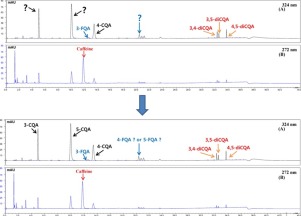Journal of Chromatography B ( IF 2.8 ) Pub Date : 2017-08-31 , DOI: 10.1016/j.jchromb.2017.08.041 Jong-Sup Jeon , Han-Taek Kim , Il-Hyung Jeong , Se-Ra Hong , Moon-Seog Oh , Kwang-Hee Park , Jae-Han Shim , A.M. Abd El-Aty

|
Coffee, a complex mixture of more than 800 volatile compounds, is one of the most valuable commodity in the world, whereas caffeine and chlorogenic acids (CGAs) are the most common compounds. CGAs are mainly composed of caffeoylquinic acids (CQAs), dicaffeoylquinic acids (diCQAs), and feruloylquinic acids (FQAs). The major CGAs in coffee are neochlorogenic acid (3-CQA), cryptochlorogenic acid (4-CQA), and chlorogenic acid (5-CQA). Many studies have shown that it is possible to separate the isomers of FQAs by high-performance liquid chromatography (HPLC). However, some authors have shown that it is not possible to separate 4-feruloylquinic acid (4-FQA) and 5-feruloylquinic acid (5-FQA) by HPLC. Therefore, the present study was designated to investigate the chromatographic problems in the determination of CGAs (seven isomers) and caffeine using HPLC-DAD. The values of determination coefficient (R2) calculated from external-standard calibration curves were >0.998. The recovery rates conducted at 3 spiking levels ranged from 99.4% to 106.5% for the CGAs and from 98.8% to 107.1% for the caffeine. The precision values (expressed as relative standard deviations (RSDs)) were <7% and <3% for intra and interday variability, respectively. The tested procedure proved to be robust. The seven CGAs isomers except 4-FQA and 5-FQA were well distinguished and all gave good peak shapes. We have found that 4-FQA and 5-FQA could not be separated using HPLC. The method was extended to investigate the effects of different brewing conditions such as the roasting degree of green coffee bean, coffee-ground size, and numbers of boiling-water pours, on the concentration of CGAs and caffeine in homemade brewed coffee, using nine green coffee bean samples of different origins. It was reported that medium-roasted, fine-ground coffees brewed using three pours of boiling water were the healthiest coffee with fluent CGAs.
中文翻译:

测定在各种条件下制得的自制煮咖啡中的绿原酸和咖啡因
咖啡是800多种挥发性化合物的复杂混合物,是世界上最有价值的商品之一,而咖啡因和绿原酸(CGA)是最常见的化合物。CGA主要由咖啡酰奎尼酸(CQAs),二咖啡酰奎尼酸(diCQAs)和阿魏酰奎尼酸(FQAs)组成。咖啡中的主要CGA是新绿原酸(3-CQA),隐绿原酸(4-CQA)和绿原酸(5-CQA)。许多研究表明,可以通过高效液相色谱(HPLC)分离FQA的异构体。然而,一些作者表明不可能通过HPLC分离4-阿魏酰基奎尼酸(4-FQA)和5-阿魏酰基奎尼酸(5-FQA)。所以,本研究旨在研究使用HPLC-DAD测定CGA(七个异构体)和咖啡因时的色谱问题。测定系数的值(R 2根据外标校准曲线计算得出的)> 0.998。CGA在3种加标水平下的回收率从99.4%到106.5%,对于咖啡因则从98.8%到107.1%。对于日内和日间变异性,精度值(表示为相对标准偏差(RSD))分别为<7%和<3%。经过测试的程序证明是可靠的。除4-FQA和5-FQA外,七个CGA异构体均得到很好的区分,并且均具有良好的峰形。我们发现使用HPLC无法分离4-FQA和5-FQA。扩展了该方法,以研究不同冲泡条件(例如生咖啡豆的焙烧程度,咖啡粉大小和沸水倒入数量)对自制冲泡咖啡中CGA和咖啡因浓度的影响,使用九种不同来源的生咖啡豆样品。据报道,使用三杯开水冲泡的中度焙炒,细磨咖啡是使用流利的CGA的最健康的咖啡。











































 京公网安备 11010802027423号
京公网安备 11010802027423号